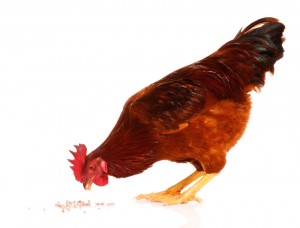Last May, Food Poisoning Bulletin reported on the state of Maryland banning the use of arsenic in chicken feed. That bill became law on January 1, 2013.
 Poultry farmers have used arsenic in chicken feed since the 1940s. It treats the disease coccidiosis, which can cause anemia and diarrhea and restricts growth. The FDA approved roxarsone (3-Nitro-W), an arsenic-based drug, for use in chicken feed in 1944. Chicks gain weight faster when fed that product, and chicken flesh was pinker. The FDA approved the use of roxarsone to promote growth and improve chicken flesh pigmentation in 1951.
Poultry farmers have used arsenic in chicken feed since the 1940s. It treats the disease coccidiosis, which can cause anemia and diarrhea and restricts growth. The FDA approved roxarsone (3-Nitro-W), an arsenic-based drug, for use in chicken feed in 1944. Chicks gain weight faster when fed that product, and chicken flesh was pinker. The FDA approved the use of roxarsone to promote growth and improve chicken flesh pigmentation in 1951.
But new scientific research has found that arsenic in poultry feed poses a risk to people that is much higher than originally thought. Chronic arsenic exposure is associated with increased bladder, kidney, lung, liver, and colon cancers. Children exposed to arsenic can develop diabetes, heart disease, and neurological problems.
In 1951, the FDA set levels for arsenic residue in poultry at 2 parts per million (ppm) in the liver, and 0.5 ppm in muscle. Consumer groups, including Food & Water Watch, say that standard is too high and should be revised, especially since chicken consumption in the United States has tripled since the 1950s. In addition, the Institute for Agriculture and Trade Policy (IATP) tested arsenic levels in grocery store chicken in 2006. They found that 55% of the samples had detectable levels of arsenic, up to 21.2 ppb.
Farmers in Maryland produce a lot of chicken. According to Food & Water Watch, poultry farms on the Delmarva Peninsula produce “more waste than a city of 4 million people.” And between 20 and 50 metric tons of roxarsone is applied to Delmarva fields every year via poultry waste used as fertilizer.
Chickens can be raised without arsenic. Europe banned the use of arsenic in poultry feed in 1999. And organizations and consumer groups are working to ban the use of arsenicals in animal feed.




